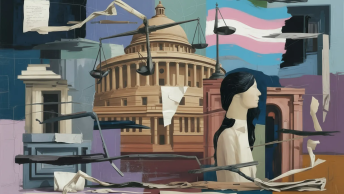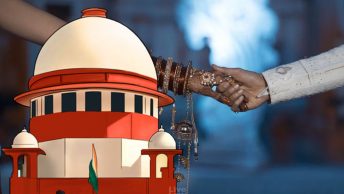[Ed Note: This piece has been published on an evolving situation with all updates till 5:00pm, 9th September having been accounted for. LAOT invites responses to the arguments made in this piece, both through our comments section as well as through a new post. We shall also publish any official response or link any new Press Release as and when we’re informed of it or come across it. It is also clarified that the views expressed are solely of the authors, in their personal capacity. Please find the Part II on NLAT here.
Authors Note: We are extremely grateful to Vishal Rakhecha & members of the LAOT Editorial Board for their continuous assistance and editorial comments over the last two days which has helped us to significantly improve our initial draft.]
The COVID-19 pandemic has created immense confusion for the entrance examination tests of various universities, one such examination being the Common Law Aptitude Test (CLAT). CLAT was rescheduled several times and was set to take place on 7 September 2020, but in light of continued lockdown in Bihar and West Bengal, the Consortium shifted the test to 28 September 2020. However, on 3 September 2020, National Law School of India University, Bangalore (NLSIU) notified that it shall conduct its own examination, National Law Aptitude Test (NLAT) on 12 September 2020 and shall not accept CLAT 2020 scores for admission.
It stated that the unforeseen difficulties and delays in the conduct of CLAT 2020 caused by the Covid 19 pandemic put it in a uniquely disadvantageous situation as it follows a trimester system and if it is unable to complete admission before end of September, 2020, it will inevitable result in a Zero Year with no admission. While NLSIU’s claim on the inevitability of such a consequence has been contested elsewhere, the authors do not analyze or comment on the same.
This Part shall delve into the legality of NLSIU’s decision of having a separate entrance test, while continuing as a member of the Consortium of NLUs – which conducts the Common Law Admission Test (CLAT). In Part II, we shall analyze the mode and timeline of the examination to argue that contrary to the Notification’s claims, the examination is not fair, accessible and transparent.
Introduction
The Consortium and National Law School of India University (NLSIU), Bangalore have disagreed on multiple issues and expressed their displeasure through their press releases and interviews. The most recent disagreement stems from the Press Release from the CLAT Consortium dated 6 September 2020, which divested Vice Chancellor, NLSIU, Prof. Sudhir Krishnaswamy from his position as Secretary-Treasurer and alleged that his actions were in derogation of the Bye-laws and the Objectives of the Consortium.
NLSIU in its Press Release, responding to CLAT Consortium, has argued that it has “not violated the Consortium Bye-Laws,” reiterated its Founding Member status and has also stated that it “has not acted in derogation of the objectives of the Consortium at any time and in any manner.” Through its Press Release, it further went on to contend that the claims made and decisions taken by the Consortium “have no legal basis or authority.”
In light of these opposing contentions, it becomes pertinent to examine the Bye-Laws and the Memorandum of Association (MoA) of the Consortium of National Law Universities.
The Consortium Regulations
It must be remembered that the primary objective of the NLUs initially coming together through their Memorandum of Understanding (MoU) in 2008, further amended in 2014, was to conduct a common entrance test as per the directions issued by the Hon’ble Supreme Court in Varun Bhagat v. Union of India and in furtherance of the deliberations made by the University Grants Commission, Ministry of Human Resource and Development, Government of Indian and the then existing NLUs. This has also been recorded by the Consortium in its own MoA. Rather, while the Consortium of NLUs was constituted in November 2014, one of the primary reasons for it to have registered itself in its present form as a society seems to have been to “further streamline conduct of Common Law Admission Test”.
Therefore, we look at these documents to analyse the legality of a Consortium Member admitting students in its law programme through a separate examination.
Bye-Law 15.3 of the MoA, which regulates the Requirement of Membership specifies in sub-clause 15.3.3
In order that appropriate intellectual rigor may be maintained, a Member institution shall ensure that admission to every academic course or programme of study in each Member institution shall be based on merit assessed through a transparent and reasonable evaluation namely CLAT operated by the Society, prior to admitting any student.
Further, the MoA notes under Clause 3(A)(v) that one of the main aims and objectives of the society is:
To administer, control and monitor the conducting of all India common entrance examination for law ie. CLAT, for and on behalf of all the participating NLUs, and facilitate admission of students into various NLUS in the country.
In furtherance of the MoA, the Bye-Laws also note that the Society (Consortium) has the power:
3.3.3. to provide for matters connected with the admissions to the Member institutions;
3.3.6. to provide platform for admission to all National Law Universities in India through CLAT for UG & PG Law Courses if such National Law Universities become the Members of the Society;
Rather, “CLAT” has itself been defined in the Bye-Laws under Clause 1.1.3 as the
all India Common Law Admission Test conducted for students seeking admission to the undergraduate or postgraduate degree programme offered by various Member institutions
Therefore, it seems that the Consortium MoA does seem to imply that all admissions must be only through CLAT as that is also a specific membership requirement. On the other hand it’s also true that NLSIU has been given special membership status in a manner. While no institution, including NLSIU, is a permanent member as per the Bye-Laws, the Vice-Chancellor of NLSIU serves as the ex-officio Secretary-Treasury of the Society.
However, if attention is paid to Clause 15.7 which deals with “Voluntary withdrawal of Member institution”, the sub-clause 15.7.3 under it does envisage not mere withdrawal but also the possibility of a Member institution that “becomes ineligible for membership.” Even though, the Bye-laws fail to lay out the procedure to hold a Member institution ineligible in detail, one of the powers of the Executive Committee as per Clause 7.3.8 includes the power to “impose or recommend sanctions upon any Member institution.”
Therefore, Clause 7.3.8 read with Clause 15.7.3 of the Bye-Laws opens the possibility of the Executive Committee holding NLSIU to be ineligible for membership of the Consortium in light of it having failed to meet the membership requirement under Clause 15.3.3. The lack of clarity however seems to have also been the reason that in its Press Release, the Consortium decided to hold a meeting to consider the necessary amendments in the Bye-Laws and MoU yesterday, however we are still to hear any updates on the meeting’s proceedings.
The only option for a member institution to bypass the same seems to be either an exemption within the Consortium or to withdraw from Consortium’s membership.
As mentioned in its own press release, NLSIU did attempt to seek an exemption by presenting several options to the Consortium which it claims were repeatedly rejected. However, a post by the Vice-Chancellor, NALSAR seems to suggest a different story, as his piece states that NLSIU did not inform the Executive Committee that they had already resolved to conduct their own independent admission test when the CLAT date was last shifted. Regardless, it seems the Consortium MoA requirements would require a Member institution to enrol students through CLAT, as long as it continues to be a Member and has not had an alternative request accepted by the Consoritum.
While this seems to be a prerogative of the Consortium and not an automatic disqualification, NLSIU’s claim that it has not violated the Bye-Laws and has not acted in derogation of its objectives by conducting a separate test while also stating that the Consortium had no legal basis or authority to act seems to stand on thin ice.
It might also be useful to take a look at the alternatives suggested by NLSIU, before the Consortium, as per its Press Release. Two of these solutions suggested allowing individual NLUs to have their own admission process, thereby completely violating the purpose of the Consortium having a common entrance test. The third option seems even stranger as it suggests having CLAT in “two or more series with some Universities accepting students from the first date of exam and the others from second date”! If the exam could have been conducted at any earlier date, why would there need to be another date? Why would the Consortium consider putting applicants twice through an entrance test process?
Autonomy of NLUs
However, NLUs including NLSIU enjoy being governed under their own statutes which also provides them greater autonomy in regulation of their admission procedure. This special status also sets these institutions apart from the general regulatory powers of State for admissions to professional institutions discussed under T.M.A. Pai Foundation v. State of Karnataka, clarified by the Islamic Academy of Education v. State of Karnataka. This is especially the case as there are no specific committees set up to monitor the process in the case of admissions to NLUs. Rather, National Law University Delhi, which is also founded under its own statute has been conducting its separate entrance test from its year of establishment.
Therefore, these claims of the Consortium must also be balanced against institutional autonomy that NLUs such as NLSIU enjoy. The NLSIU Act does give the prerogative to its Executive Council to decide the mode of enrolment or admission of students, although not without prior concurrence of its Academic Council. While the Executive Council’s permission was taken as mentioned in NLSIU’s Revised Admission Notification, it continues to remain unclear whether the prior concurrence requirement of the Academic Council was fulfilled.
Clearly, NLSIU does have the power under its Act to choose the mode of admission, if it follows the procedure laid therein, however, it may still be questioned whether the University can choose a different route of admission of students without first withdrawing from the Consortium, where membership of all institutions is on the basis of their conducting admissions through CLAT. Though Islamic Academy of Education would not be directly applicable, on the timeline it may be relevant to note that the Court had stated that “the option of choosing, between either of these tests, must be exercised before issuing of prospectus” by professional colleges whereas NLSIU’s move comes much later.
NLAT not only has a modified format, it was notified a mere 10 days before the date it is scheduled to be held on and months into NLSIU having been actively associated with CLAT 2020. Of course, NLSIU has justified this parting away from CLAT on the basis of CLAT’s unforeseen postponement.
NLSIU’s claim that it can hold a separate entrance test while continuing to remain a member of the Consortium does not merely create hardships for CLAT aspirants this year, but it also sets a dangerous precedent. This would mean that in future, any NLU can continue to be a member of the Consortium and yet on the shortest notice decide to go for its own exam and even go to the extent of refusing to publish the consolidated Merit/Admission List (Clause 4.5.4, NLAT Notification).
Conclusion
In Varun Bhagat v Union of India, Common Law Aptitude Test was conceptualized to make the process more accessible, certain and student-friendly by ensuring that students do not have to write multiple exams at varied locations. It has taken more than a decade for the establishment of the current CLAT mechanism of a Permanent Secretariat where 22 National Law Universities collaborate their admissions through one exam. It is sincerely hoped that NLSIU will reconsider its position and its decision would not lead to putting into jeopardy the years of effort of getting all NLUs together for a delay of merely 15 days.
On conducting a separate test outside the Consortium, multiple judgments have held that Courts can still intervene if entrance tests are found to be unfair or lacking transparency. In Part II, we will analyze the multiple issues that NLAT faces in light of its mode and structure, including the lack of transparency in the examination.
The NLSIU Student Body has recognized the hardships and is assisting access issues faced by applicants. Such applicants can fill this Google Form to get in touch with the student body. You can also reach out to them at laptopsfornlat@gmail.com. If you are willing to lend your laptop/ webcam/ dongle/ space to interested applicants facing access issues, please fill this Google Form and the Student Body shall put you in touch with the aspirant.








Can you be more specific about the content of your article? After reading it, I still have some doubts. Hope you can help me.